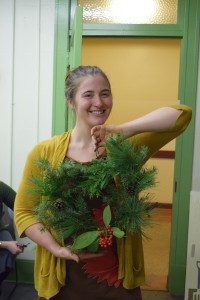
As a symbol of strength and prominence, the wreath has adorned crowns and dwellings of humankind for thousands of years. And in the dead of winter when little else grows, what better way to pay tribute to our region’s resident evergreen trees than to make our own wreaths from fallen branches?
After all, these benevolent green giants help with stormwater management, shelter us from inclement weather, clean our polluted air, maintain privacy, buffer noise, assist with erosion control, supply building materials, heal human ailments, provide food and shelter for countless species of wildlife, and so much more!
Ingredients
• 1 wire coat hanger
• Florist wire
• A pair of pliers
• A pair of scissors
• A pair of handheld pruners
• Boughs from fallen evergreen trees (cedar, pine, fir, Douglas fir, etc)
• Optional: 5-gallon bucket, a pair of loppers
• Other decorations: Bow or ribbon, colorful deciduous twigs, sprigs of berries (winterberry, holly, etc), pine cones
Make a Wreath
1. Use pliers and/or 5-gallon bucket (as a mold) to shape the open, triangular part of the coat hanger into a circle. Refrain from untwisting the hook, as you will use it to hang the finished wreath.
2. Collect your boughs and prune to approximately 12” in length. Use handheld pruners or loppers to remove wood of branches wider than ½” in diameter.
3. Bundle some greens and wrap the ends thoroughly with floral wire.
4. Lay the wire-wrapped end along the wire rim of the coat hanger circle. Thoroughly bind the bough bundle to the hanger wire with floral wire.
5. Continue to wrap the floral wire around the bundle and coat hanger wire. As you wrap down the branch, add more boughs (and sprigs of berries or colorful twigs, if desired) and wrap as you go.
6. Keep adding boughs and wrapping with wire until you fill the entire coat hanger wire circle.
7. When finished, add a bow or additional decorations as desired.
8. Hang from coat hanger hook on your door. Enjoy!
Benefits of Winter Trees and Shrubs
Evergreens
All evergreen trees help to manage rainwater through evapotranspiration (heightened water vapor evaporation thanks to the plant’s own breath) and underground water absorption. This is incredibly important in an urban environment, where impermeable surfaces like roofs and pavement prevent water from infiltrating the soil and cause excessive runoff. Evergreens also mitigate erosion with deep roots; protect from wind, heat, loud noise and neighboring eyes; filter the air; and offer much-needed food and shelter for birds, mammals and insects.
Western Red Cedar (Thuja plicata) – A mother tree of the Pacific Northwest, Western red cedar is long-lived and, thanks to its strong antifungal and antimicrobial oils, it is very decay resistant. Fallen trees can last over 100 years! Can be used untreated to build long-lasting raised beds or worm bins. Used by native tribes for canoes, baskets, clothing, rope, paddles, medicine, etc.
Pine (Pinus spp.) – The nuts in all Pinus species are edible, though some are tastier and more accessible than others. Whitebark pines (P. albicaulis) and Korean nut pine (P. koraiensis) are especially delicious. Medicinally, the new needles are high in Vitamin C. Pines provide significant food and habitat for wildlife.
Douglas Fir (Pseudotsuga menziesii) – Technically in the pine family, and not actually a fir, Douglas grows bright green tips that are great sources of electrolytes and Vitamin C. Compared to many other pines, cones do not have a lot of seeds but still offer significant forage for wildlife.
Fir (Abies spp.) – Firs can grow in high-altitude and other difficult bioregions, so in myth they symbolize strength and immortality. Cones are resinous and sit upright—like candles—on the top of branches. Food and habitat for wildlife and medicinal uses for humans, especially for lungs.
Deciduous Shrubs & Berries
Deciduous shrubs can provide winter interest not only in your cool-season garden, in the dead of winter, but also on your wreaths/in bouquets. Leaves feed the soil. Berries feed the wildlife.
Snowberry (Symphoricarpos albus) – Notable for its white, puffy fruit that lingers along the stem throughout winter, snowberry is a solid staple for a mid-level plant that spreads out to create a small thicket to house larger birds and small mammals. Small pink flowers in May-August, feed native bumblebees and hummingbirds. While inedible for humans, the berries feed birds and even browsing deer and elk.
Winterberry (Ilex verticillata) – Commonly found in holiday bouquets or at local nurseries for winter décor, winterberry is native to the Eastern United States and is a popular source of winter snacks for birds like cedar waxwing and robins. The shrub ranges in height from 3-12 feet and is dioecious, meaning each plant is male or female; luckily one male winterberry can pollinate up to 10 females! Discreet white flowers appear in June to July and are a favorite of native pollinators.
Juniper (Juniperus spp.) – Fragrant foliage akin to gin. Leathery and often pokey leaves with scale-like quality. Fruits are leathery and appear to be small, hard berries but are actually round cones. Junipers are dioecious (male and female flowers on separate plants). Native to our area: Western juniper, common juniper, Rocky Mountain juniper and Seaside juniper
Red & Yellow Twig Dogwood (Cornus sericea) – Also called Osier dogwood, this Pacific Northwest native grows to a height of 6-12 feet and boasts bold, smooth stems of flamboyant red or yellow in the cold season. Birds (warblers, kingbirds, robins, flickers, etc) and mammals of all sizes adore the berries, butterflies sip on flower nectar, spring azure butterfly larvae nibble on the leaves, and host for insect larvae (spring azure and others), and beavers use twigs to repair or build dams.
To learn more about good plant choices and placement, nurseries that offer bare root plants and proper care for your new plants, please contact the Garden Hotline at (206) 633-0224 or email us here.
